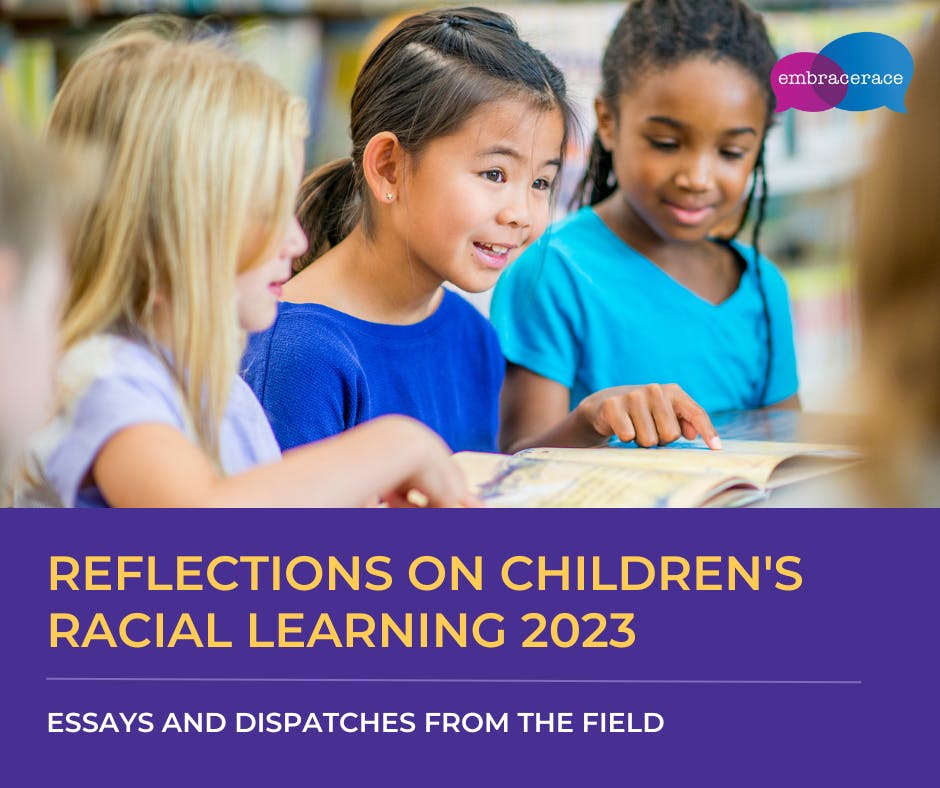The Path Forward
by Andrew Grant-Thomas & Melissa Giraud, from EmbraceRace's 2023 Reflections on Racial Learning

My goodness.
Given limited space and time, contributors to these Reflections on Children’s Racial Learning could lift up only some of the relevant efforts within the sectors we asked them to consider — Parenting Practice, PK-12 Education, Children’s Media, the Health Professions, and Social Science Research. And yet this brief survey-of-sorts makes clear that a lot of good work is happening, that the pace of that work has quickened, and that much more work is needed. The eagerness to do that work is evident.
Across the essays and dispatches we hear a few resonant themes. For one, those of us concerned to raise kids who are thoughtful, informed, and brave about race encompass a wide range of identities. We are teachers, administrators, pediatricians, therapists, social workers, television producers, researchers, and community organizers, parents, grandparents, and children. We live in “red” states as well as “blue” and “purple” ones in all regions of the country; in urban, suburban, and rural areas and small towns. We describe ourselves as conservatives and progressives, as Republicans, Democrats, Independents, and otherwise — though not in equal parts. We occupy the full spectrum of racial identities, as do the children we love.
Second, the mobilization around children’s racial learning is happening at the institutional as well as individual levels. Even as legislatures and school boards across the country clamp down on schools’ ability to create honest spaces to teach and learn about race and racial justice, a multisectoral set of nonprofit organizations and initiatives like we are, Self-Evident Education, Little Uprisings, One Talk at a Time, and What Is Black? serve growing audiences even in places often thought hostile to such offerings. Some smaller and larger professional associations — the National Association for the Education of Young Children, the American Psychological Association, the Society for Developmental and Behavioral Pediatrics, and the Society for Research in Child Development, for example — follow suit. The increased leadership of people of color in some such organizations surely helps fuel this progress.
If we are to transform the landscape of how and what children in the United States learn about race, we must organize ourselves with purpose and vigor, at much greater scale, within and across sectors.
Third, these Reflections make hearteningly clear that our children aren’t simply waiting to be saved from the racial ignorance, fatigue, fears and anxieties that unsettle so many of their elders. Children are speaking up. Speaking up for books, television shows, and movies whose characters and storylines reflect the fact that fully half of US children are children of color. Speaking up against book bans and in favor of forthright conversations about the play of race, ethnicity, religion, nationality and immigration in US history — and for honest exploration of how historical dynamics shape the realities and trajectories of communities today. As Tanya Nixon-Silberg reminds us, many kids, not least our kids of color, are speaking up for their right to speak up!
Finally, our contributors make plain that if we are to transform the landscape of how and what children in the United States learn about race, we must organize ourselves with purpose and vigor, at much greater scale, within and across sectors. Done well, such organizing — among researchers, parents, and educators, for example — would generate more evidence-based racial learning tools that better account for the cultural contexts and settings in which they will be used. It would help identify more effective ways of getting those tools into the hands of the growing number of community organizations working directly with parents and educators. And, generally, it would seed more communities and networks of stakeholders committed to the vital work of deepening and extending our color-brave learning, advocacy, and caregiving practice.
Above all, throughout these Reflections we hear a call for diligent field-building that improves and complements the work being done. We want to hear your thoughts about what field-building might entail.
For example:
What if, together, we created some bits of infrastructure to help us identify, organize and connect practitioners and researchers, individuals and organizations in the emerging field of children’s racial learning? Those tools could include a digital Map that locates groups doing relevant work in the United States, a Calendar of online and in-person events open to the public, a Directory that allows us to identify ourselves and our work to each other, and a Listserv that allows us to connect with one another. The steps involved might include planning, fact-finding, and developing technical solutions and hosting.
What if we established a research-practice network to develop and encourage the widespread use of promising, practical interventions caregivers could use to nurture healthy racial attitudes and behaviors in children? We could support researchers and practitioners to partner meaningfully throughout the research process, from identifying key questions to analyzing and disseminating findings. We could make the most promising interventions more widely known, understood and available to practitioners and help further mobilize a diverse field of researchers and practitioners working together.
What if we organized a recurring national conference on children’s racial learning? Conferences can be powerful vehicles for field-building. Imagine parents, educators, researchers, media folks, young people, funders, and other key stakeholders gathered together to identify scalable evidence-based practices; build capacity to foster resilience in children, families, and communities; and develop networks to support work that promotes healthy racial identity development. What if this conference became a signature event in the emergence of the field?
WE WOULD LOVE TO HEAR FROM YOU
Complete this feedback form to let us know what you think of these ideas, contribute your own, and/or offer feedback on these Reflections on Children’s Racial Learning.
At EmbraceRace we are committed to the power of the possible. We believe it is possible to nurture multiracial generations of children with the skills, sensibilities and will to bend the arc of possible US futures toward those in which children and adults of color, and all of us, thrive rather than merely survive. Let’s make it happen.
Yours in possibility.
Melissa Giraud & Andrew Grant-Thomas, EmbraceRace Founders

This article comes from the introduction of Inaugural EmbraceRace Reflections on Children's Racial Learning. Download all the reflections from leaders attending to children's racial learning in parent practice, education, healthcare, children's media and social science research.
Andrew Grant-Thomas

Melissa Giraud



